Every once in a while we receive an inquiry from a reader simply asking “where can I find X?” This recent inquiry definitely piqued my interest:
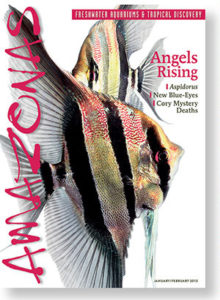
AMAZONAS Magazine, Volume 2, Issue Number 1 – Angels Rising. This is the issue that has Tom dreaming of Altum Angels! Click to order a printed back issue.
Dear Sir,
I’ve been reading your magazine for several years and it always remains as interesting and wonderful as the first issue. I recently revisited the Jan/Feb 2013 issue regarding angelfish. I’m an avid hobbyist and would like to purchase Altum Angelfish. Would you know of any that might be available here in the US?
Thanks again for a wonderful magazine,
Tom R.
First Tom, thank YOU for all those kind words!
Now, as we say on the “Interwebs,” “Fish keeping hive mind, where can Tom find his real, legit, true Altum Angelfish?”
Here’s my answer, and some details on my own pursuit of this highly-coveted species. I ask you all to consider weighing in as well in the comments section below! Hopefully we can help Tom find his Altums without all the headaches I had to deal with!
Availability Issues with Pterophyllum altum
I should point out that P. altum is rarely bred in captivity. For the most part, the Altum Angelfish found in the trade are usually wild-caught; captive-bred Altums are few and far between, and good quality ones are more expensive than comparably-sized wild counterparts. There are boatloads of fishes, both wild and captive-bred (usually labeled as “tank raised” in the freshwater trade), which make their way around the aquarium trade with the moniker “Altum” attached, yet are certainly not P. altum. Here’s some examples:
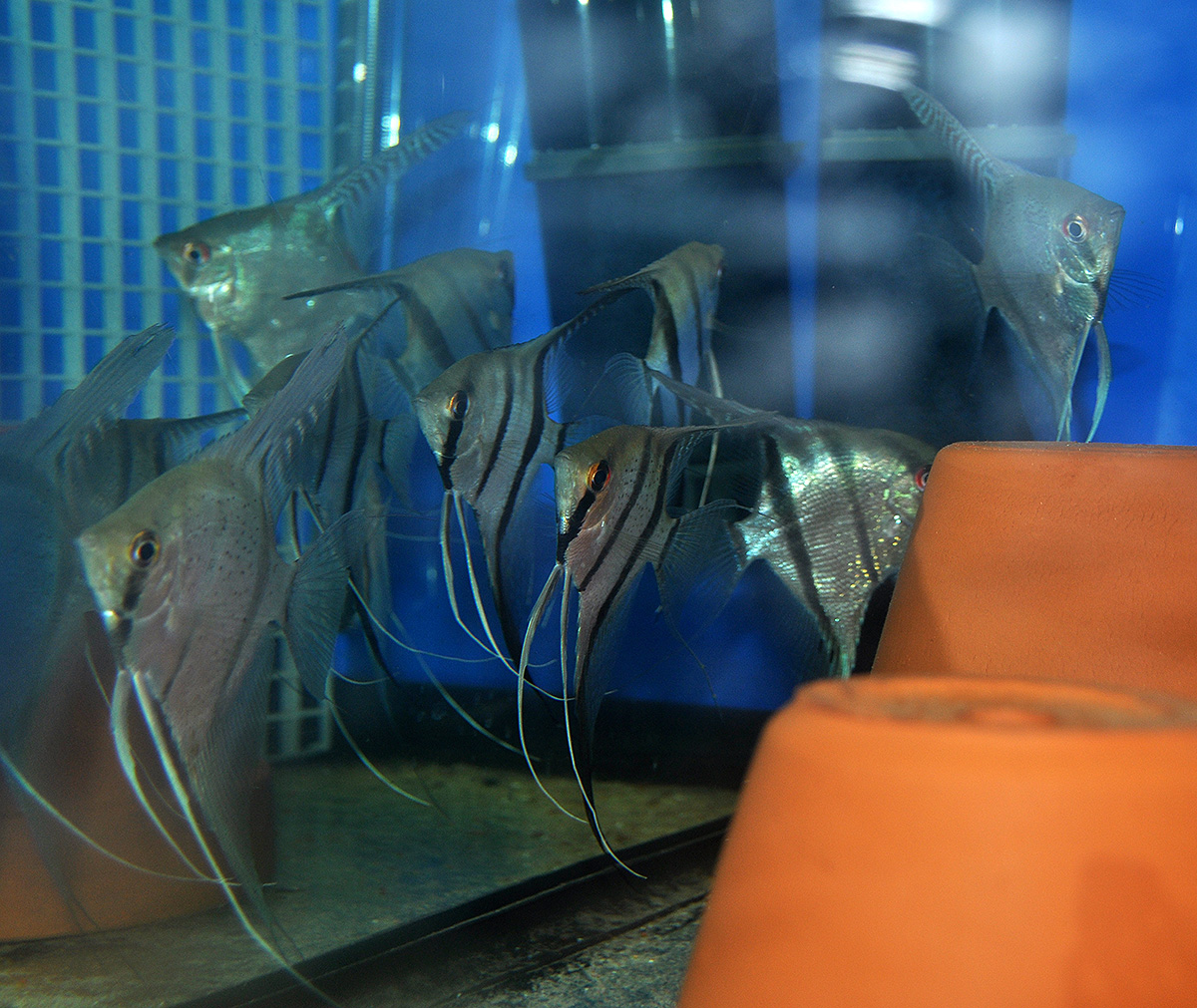
An assortment of wild angelfish purchased as “Ecuadorian” Altums. Not only is Pterophyllum altum not found in Ecuador, but as the fish settled in it became apparent that there may have even been more than one type of wild angelfish variant in the mix, with some fish showing hints of “Rio Nanay” type patterning, and others appearing more like “Manacapuru” Angels. Definitively not real altums, and the price given their size should have been a dead giveaway.
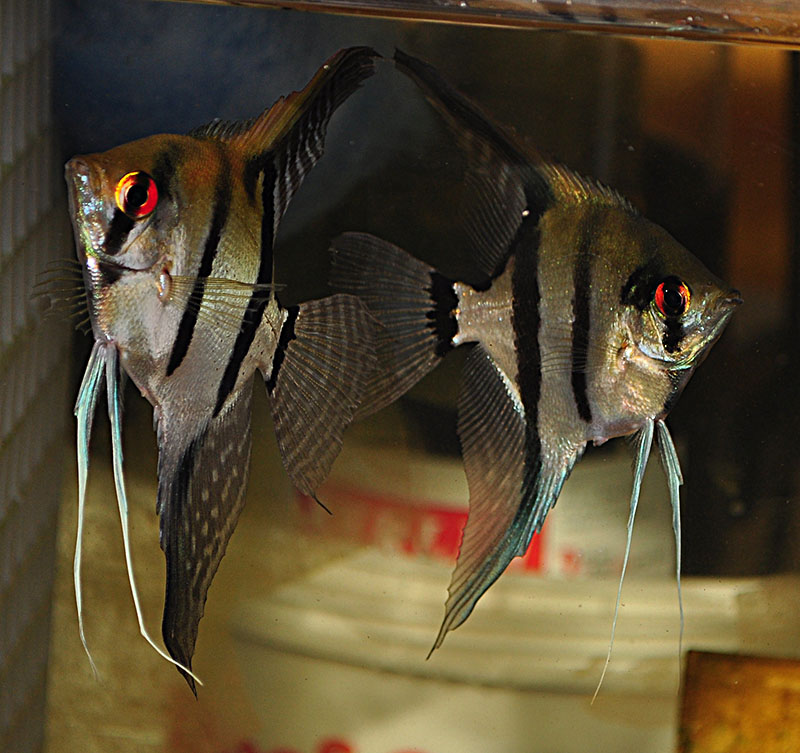
These young silver angelfish egregiously sold as “Captive Bred” or “Tank-Raised” Altums were definitively not Pt. altum, despite carrying a price tag which might have suggested otherwise. They did make really nice wild-type babies…but certainly no altums.
There is a fair amount of seasonality in the availability of wild Altum Angelfish due to annual scheduled fishery closures in their native countries; I tend to think of “Altum Season” as mid-summer going into late fall (learn more about the journey wild Altums make from the Orinoco to your aquarium in AMAZONAS Sr. Editor Mike Tuccinardi’s companion article, Altum Origins: the Supply Chain of Wild Altum Angels).
Getting Altums out of season is extremely difficult. Prices vary wildly on P. altum depending on size, season, and mortality rates. Yes, P. altum has a reputation as being a difficult fish to successfully import and establish in captivity.
Overall, finding P. altum in the U.S. feels like chasing an apparition. They’re not generally available through common channels. In my personal experience, simply ordering them from a list will usually give you something OTHER than P. altum, which means that special ordering through a local fish shop is risky for both you and the shop. You might get lucky and find an aquarium shop stocking them locally, but that’s exceedingly rare. On the rare occasions a shop gets real, true P. altum, at least here in MN, they were always gone before I could even get to them, and the quality seemed to be a rather mixed bag.
Resorting to Online Sources
I was forced to deal with online vendors, and in the world of P. altum, that can be incredibly risky. Things didn’t always turn out well…in fact, some of my worst online fish buying experiences ever dealt with trying to procure Altums. A tremendously poor shipment of incredibly undersized wild fish in which many were DOA and nearly all were dead 48 hours in wasn’t the way anyone wants to start out.
The DOA Altums shown above were sold as wild-caught, 3-4 cm sized fish, and the sales images used to sell these fishes showed juvenile fish in that nickle-to-quarter body size range. Generally, I measure fish length from head to tail, the differences between standard length (SL) and total length (TL) understandable sources of minor deviation and confusion. I put it to you, the reader, are these 3-4 cm fish?
Given the DOAs and the sizes, any vendor should expect a complaint asking to be made whole. The DOAs were blamed on the shipping carrier (and not what I felt was improper packaging). The first rebuttal on size was that “Altums are measured in height”. Even so…3-4 cm? It took this picture, with scale in CM, to finally make headway. Ultimately, I was told the vendor was burned by his vendor; I presume the expectation was that the I somehow wouldn’t be upset? To the unnamed vendor’s credit, ultimately better-sized fishes were shipped, but it’s not an experience I’d ever want to repeat.
Ultimately, I found that doing a bit of asking around, but also being lucky, is what paid off. I have no hesitations in sharing that my best Pterophyllum altum were all purchased from Houston Aquarium Warehouse, a local retailer and online vendor. Even then, it wasn’t a perfect shipment; wild Altums certainly are sensitive to shipping. I suspect if the trade treated them more like marine fish they’d fair better.
So while my actual real Altums were “expensive” compared to the average domestic angelfish, the reality is that there was also a large amount of additional investment in what amounted to bad purchases and incorrect fish; my Altums cost a lot more than simply what the invoice states. If you’re going to pursue Altums, you need to have a certain tolerance for risk, and the money to take a gamble.
Getting Ready for Altum Angelfish
I’ll also add that many online sources suggest that receiving wild Altum Angelfish requires a lot of water chemistry modification with acids to produce extremely low pH ranges. I found that counterproductive. I may have actually acid-burned some of my initial charges trying to chase these extremely low pH ranges that “everyone” seemed to suggest I needed.
My local tap has a very high pH, although it is artificially induced (I’ve been told to help prevent things like lead pipes leaching into the water supply). That said, the TDS of our tap water is very low (typically 42 ppm). Once I stopped trying to chemically chase a specific pH, and instead just used my tap-water as-is, my Altums flourished. This suggests that a better route for Altums might simply be to use RO/DI water, mixed with local tap, to create a relatively soft water, and to not fret over a target ultra-low pH.
The “need” for low pH stems from suggestions that an ultra-low pH inhibits bacterial growth and therefore helps prevent common issues with Altums (Columnaris infections being one in particular). That said, UV sterilizers, blackwater extracts, peat filtration or Indian Almond leaves could all be used to further condition the water and limit bacterial growth without creating a chemically unstable pH, teetering on the brink of crashing your tank and killing the inhabitants.
Live baby brine shrimp is a great recovery food for small Altums following their journey. In the long run, all of my Altums made the transition to flake and pellet feeds as staple diets. Large routine water changes (50% weekly) seem to be very effective with my Altums. I’m now at the point where my Altums are pairing (and killing off the subordinate fish – I need to watch them more closely!). So success can be had, and once the fish settle in they thrive if given good care.
Be sure to read Mike Tuccinardi’s Altum Origins: the Supply Chain of Wild Altum Angels for some additional insights that might help you be more successful when purchasing wild Altums.
So now I’ll turn this over to our readers. Where would you suggest that Tom find the elusive Pterophyllum altum?

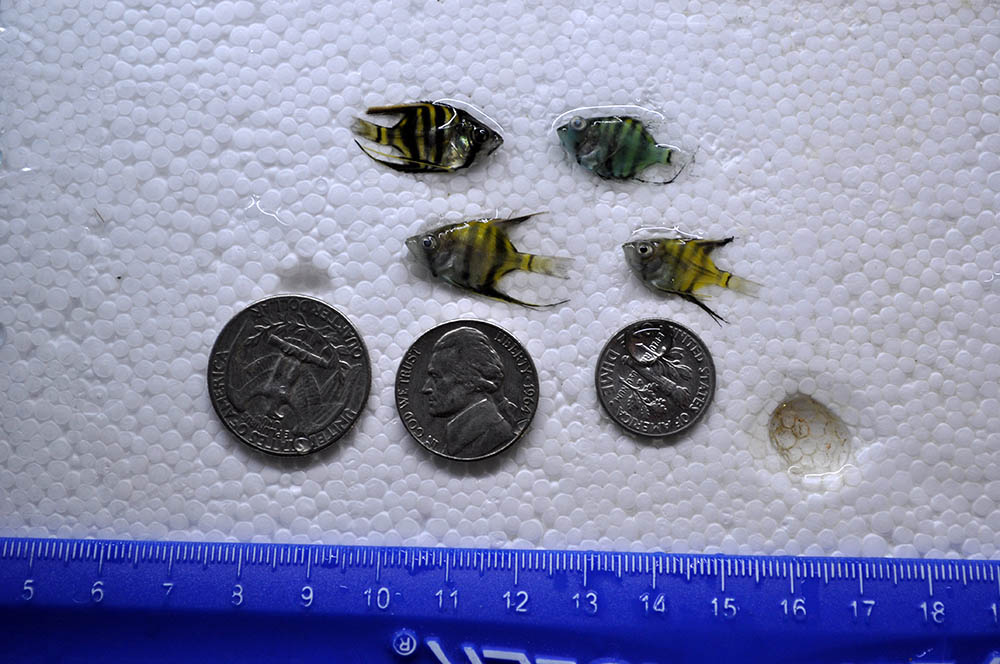
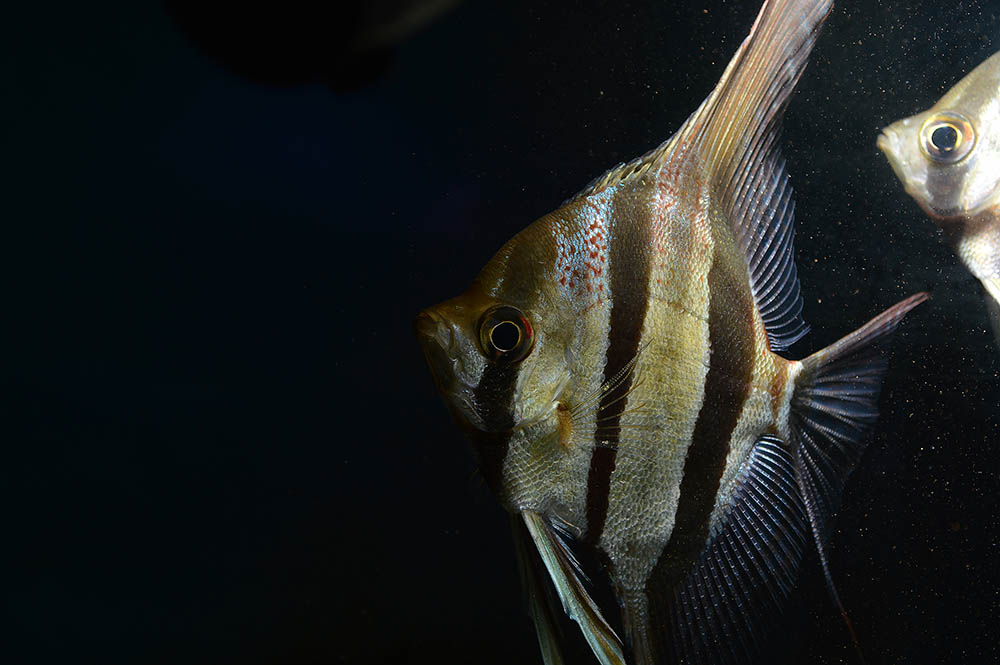
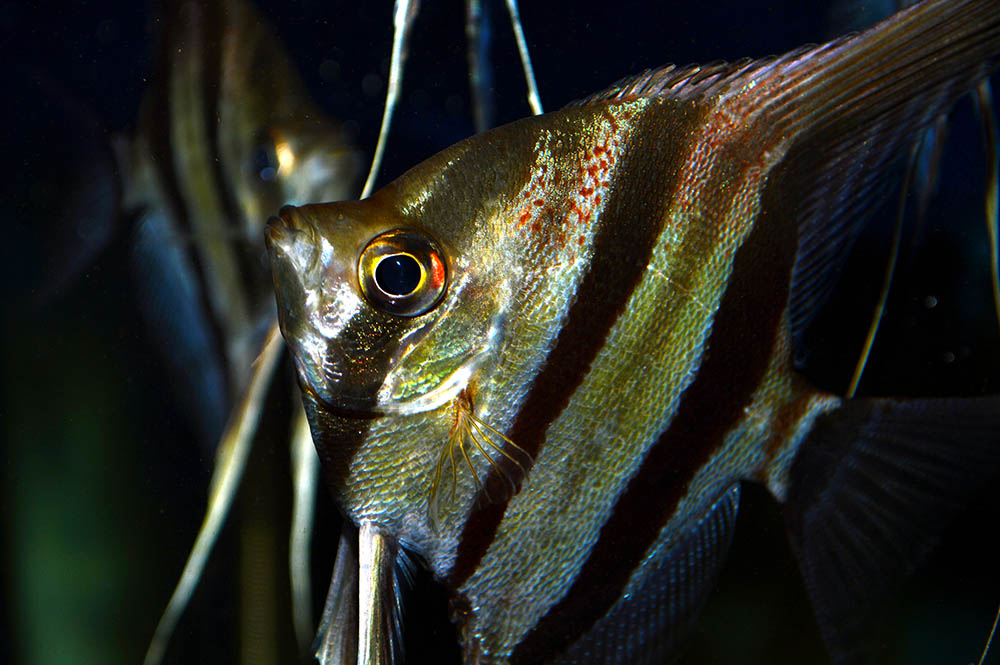





Try Jeff Ramps at tangledupincichlids.com
I would suggest he try Houston Aquarium Warehouse or Tangledupincichlids ran by Jeff Rapps. The Wet Spot in Portland Oregon might be another source as well. Happy Fishkeeping!!! I would also suggest Finarama.com as a source of information regarding angelfish, especially altums.
If you are ever in Alberta Canada I typically keep 10-50 at a time and I sell them at TL 5-6″ all the time. They aren’t rare but more difficult to acclimatize to our pH of 8.2-8.4 but there are a few tricks involved! I ship mine direct from Colombia but ask for 2 heat packs in each box with the xl sizes bagged individually like large discus. I see a lot of stores selling the Altum x scalare crosses which is such a crappy disservice to the Altum. F1’s are supposed to be coming out of Asia now but they once again have high morality rates in shipping. Keep the temp high, offer ghost shrimp, brine shrimp and even cardinals! And watch them recover quickly! Ammonia burns are best treated with furancin green, 2-3% salt and 82-84F.
Hey Curtis,
I am looking to buy some Altum Angelfish. You are saying you sell them….. Is it possible to ship them to Toronto, Ontario?? If yes, please give me your contact info and I’ll get in touch. My contact number is 4169104132
I just sold all my Altums to a guy in Toronto and I have stacked my tanks in my garage until Jan 2017. You can check with Canadapleco.com as I had sold them on that site and Marte may have bred them by now as they were 7-9″ TL.
I see them on my lists and they are Altums from the Atabapo River where I see a lot more red on the fins than the other locations.
Please email me if you have Altums in Alberta
Someone just mention the wet spot and they at this very moment have 3 post up on aquabid.com saling fake true wild altums. If you look notice the mouth, the snout it goes straight down to a point like the ugly 5 dollar angelfish at pets smart lol. In the true wild altums notice the from the head going down to the mouth you’ll see that right before you would reach the mouth it all the sudden pokes a little downwards and a little outwards all the sudden. And the fake ones notice the finest are different from a true altum.
Hey Josh, I literally just hopped on AquaBid and didn’t see ANY offers of “altums” at all, fake or otherwise. But as you no doubt garnered from my experiences in the article above, finding true altums can be more difficult than simply buying a fish called “altum”. Definitely a buyer beware type of situation around this species.
Hey matt pederson. There is 2 seperate altums listed for sale right now. And the others got removed because aquabid agreed they were obviously false. I reported it.
It appears that discususa has some Altums in stock now. They appear to be legit.
Maybe I’m wrong?
http://discususa.com/epages/837c2f23-61ea-4645-82f2-3b56290a54a4.mobile/en_US/?ObjectPath=/Shops/837c2f23-61ea-4645-82f2-3b56290a54a4/Products/%22WC-Altum%20Angelfish%22/SubProducts/%22WC-Altum%20Angelfish-0037%22&ViewAction=ViewProduct
I have purchased Altums from David Labell, owner of Duscususa. They were awesome. Besides he has excellent shipping and customer service! I would buy from again anytime.
where I can buy Altum Angel fish? Pls help
There are two breeders in the USA producing captive bred true altums. I will not blast their names all over the net, however with some observation and patience you can find them in discus inside out on FB.
Discus origins sells true altums as well as red Santa Isabella “altums” which are actually rarer and perhaps prettier.
Snookn21 on aquabid sells WC true atabapo altums however does not list them on aquabid. Available on his website. Also many wonderful wild discus too.
On starting sick imports!! Hit them with plenty of aeration, utilize melafix and Pima fix for a few days. In my experience wipes out common funguses due to transport. 88-90F.
Second week begin treatment with vitamin B complex and Vit C. I added carbon during this period so that it would remove the Vit B after 24-48, done purposely due to vitamin degradation. Treatment of 1 tab of each in RO water in a blender add solution to tank every 3rd day. Vitamins improve health and repair damage.
For the love of god when taking in WC altums use conductivity meters utilize TDS matching and get them out of the filthy water they were shipped in.
Once stabile treat for gill flukes and worms. Flubendazole and Levamisole both function well in the water column!
29/30 survival rate for a very bad shipment!!!
It is a sad fact that most of the aquatic trade does not treat this fish with the care it deserves. In the UK David Lai is one of the few dealers who takes the trouble to acclimatise these fish soundly. I would take issue with the statement that the good tank breeds are too costly, if you factor in the mortality of wild fish, offerings such as those of Simon Forkel win hands down. The thing many people fail to realise about this aspirational fish is that it takes a lot of housing (45 cm tall fish take up a lot of room). They are large piscivorous Cichlids that like to knock each other about as the hierarchy constantly changes within the group.
If you’re in NYC vicinity, then I recommend Monster Aquarium in Flushing NY. Check out their FB pages, it’s a small store with lots of exotic and hard to find pets. They just recently posted that they got altum Angels for sale!
If you’re in Manhattan , then the place to go would be Pacific Aquarium on the lower east side. You can also check out their FB pages first. They’ve a lot of weird and exotic stuff too, although I’m not sure about the Altum presently.
I had great success using peat moss from Home Depot or Lowes. I bought a separate Canister filter and stuffed it with the peat moss. It tainted the water a beautiful color and lowered the PH. My Altums thrived . Also feed them plenty of live foods.
Matt,
If I can high jack the comments a bit, if Altums seem tough to get, perhaps the aquatic plant equivalent, but worse, and a pet peeve of mine, is the lack of U.S. availability of Cryptocoryne aponogetifolia. With Crypts such a popular group of aquarium plants, and I would consider this the “king” of the Crypts, how is this possible? Apparently it is widely available in Europe, to the point, who knows, maybe they are using it as a salad green, even utilized in E. African cichlid tanks because it comes from hard water areas in the Phillipines. I have tried to track this plant down for years both in the U.S. and Canada. I have talked to multiple specialty planted tank fish stores and businesses, and the majority have not even heard of this plant!!! It’s on my bucket list, to see this plant alive and in the flesh someday!
Jerry, what an interesting response, and you’re right, at first glance, I wasn’t able to easily track this down online! Hmm!
Matt,
Apologize it was a bit off topic.
But what a plant!
I know, I know, it’s a bit large for the average tank,
but still!
Quite a few years ago there was a great article about it, I believe in Aquatic Gardeners magazine.
I hope it will be available over here sometimes soon.
Jerry
And I think it would look great with Altums!
This link is dead. Houston Aquarium Warehouse,
Ultimately, I found that doing a bit of asking around, but also being lucky, is what paid off. I have no hesitations in sharing that my best Pterophyllum altum were all purchased from a local retailer and online vendor. Even then, it wasn’t a perfect shipment; wild Altums certainly are sensitive to shipping. I suspect if the trade treated them more like marine fish they’d fair better.
10 may 2017
I have 6 wild caught Altums in my tank the plants that y use in my tank are Echinodorus uruquayensis , Nymphaea glandulifera, Helanthium bolivianum, Ceratopteris pteridoides. These plants are all from South America and are available in Holland, these plants can grow at a temp.28 C and are very easy they don’t need much light y use 3 × 58 watt and the plants are growing on pure sand.
Rene ( sorry my englisch is not so good )
Looking for WILD Redback manacapuru and Rio Nanay Angels. Any suggestions?
Hi
Nice article. What is the difference between the “Orinoco altum” and the “Atabopo alum”
I’m waiting for the juveniles to start coming into the wholesaler around September but would like to know if these are actually different strains. I usually pay $7 per fish with a nickel size body.
Thanks
Hello,
I need to buy Altum Fish but I don’t know where I can get it. Any suggestion? Pls help. Thanks.
I received a shipment of five Pt. Altums from Jack Wattley. That’s right, the well known Discus whisperer has some VERY good quality young, wild caught Altums. They were, I feel, a fair price, but not inexpensive. The fish arrived healthy and are BEAUTIFUL. They’re eating flakes and frozen foods and are quickly taking over my 150 gallon plant tank. You can always trust Jack Wattley. You truly get what you pay for, and I don’t think I could have found healthier anywhere else. I highly recommend buying your Altums from Jack and Gabriel.
That’s a great recommendation, Michael, thanks for sharing it!
im never succes to keep this fish.. always dead. sad
Received 4 wild Orinoco Altums from Wetspot around 6 months ago. They ate flake and frozen food from day one. I have had no bacterial issues- illnesses of any sort. I did treat with praziquantel when received them. I wonder if I should also treat with flubendazole or levamisole? I see no indication it is needed. My Ph is not very low- 7.2. TDS averages around 100. KH 3; GH 5.
When Are we going to see some wild Altum s in the uk, can anyone suggest a good source for these magnificent animals.